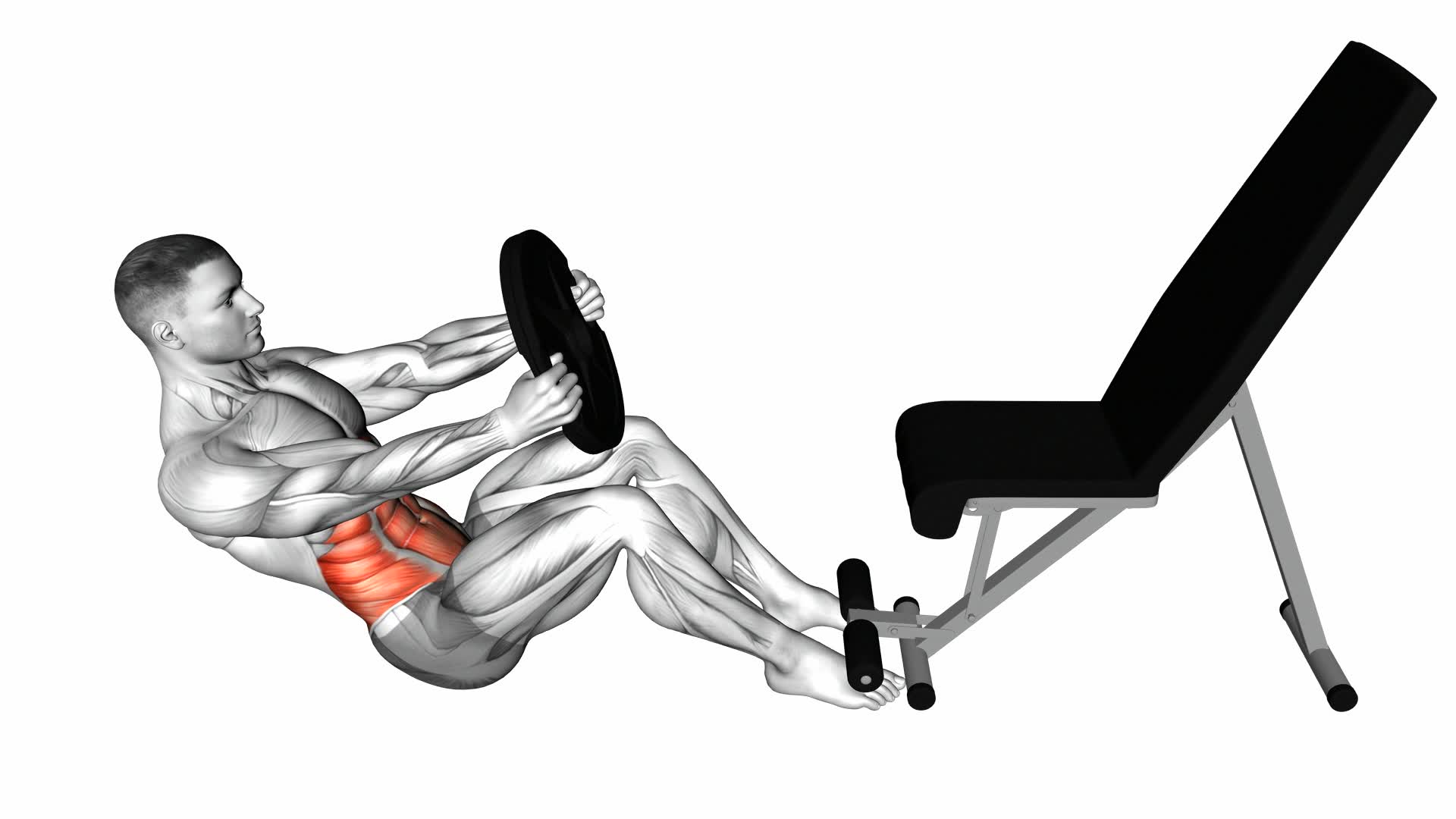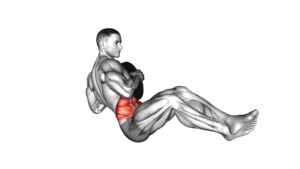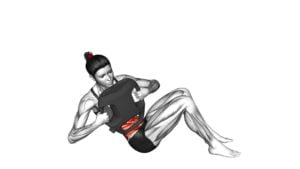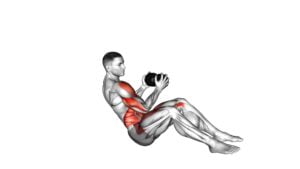Weighted Russian Twist (VERSION 2) – Video Exercise Guide & Tips

Are you looking to take your Russian twist workout to the next level? In this video exercise guide, we'll show you how to perform the weighted Russian twist (version 2) with proper form and technique.
Watch This Exercise Video
You'll also learn how to choose the right weight, modify the exercise for beginners, and discover advanced variations for fitness enthusiasts.
Follow our tips to maximize your results and get the most out of this challenging core exercise.
Let's get twisting!
Key Takeaways
- Maintain a stable seated position throughout the exercise.
- Choose the right weight that challenges you without compromising form.
- Beginners should start with lighter weights and focus on proper form and technique.
- Advanced variations include using a single-leg, medicine ball, suspension straps, or plyometric movements.
Proper Form and Technique
To perform the Weighted Russian Twist (VERSION 2) with proper form and technique, maintain a stable seated position throughout the exercise. This is crucial to avoid common mistakes and maximize the benefits of the weighted Russian twist.
One common mistake is rounding your back, which can strain your spine and diminish the effectiveness of the exercise. Instead, keep your spine straight and engage your core muscles to stabilize your body. This will help target your obliques and improve your rotational strength.
Another mistake is using too much weight. While adding resistance is beneficial, using excessive weight can compromise your form and increase the risk of injury. Start with a manageable weight and gradually increase as your strength improves.
The weighted Russian twist offers several benefits. It targets the oblique muscles, which are responsible for rotational movements and contribute to a strong core. This exercise also improves stability, balance, and posture. Additionally, it can enhance athletic performance and help prevent lower back pain.
Choosing the Right Weight
Choose the appropriate weight for the weighted Russian twist by considering your current strength and fitness level. It's important to select a weight that challenges you without compromising your form or risking injury. One of the common mistakes people make is choosing a weight that's too heavy, leading to improper technique and potential strain on the lower back. On the other hand, opting for a weight that's too light may not provide enough resistance to effectively target the core muscles.
To determine the right weight for you, start with a lighter weight and gradually increase it as you become more comfortable and confident with the exercise. Remember, the purpose of the weighted Russian twist is to engage the abdominal muscles and obliques, so choose a weight that allows you to perform the exercise with control and stability.
The benefits of the weighted Russian twist include strengthening the core, improving rotational power, and enhancing overall stability. However, it's essential to be mindful of the risks involved. Using too much weight or performing the exercise with improper form can lead to strain or injury in the lower back, neck, or shoulders.
Modifications for Beginners
For beginners, try modifying the weighted Russian twist by using a lighter weight or performing the exercise without any added weight. This modification is a great way to ease into the exercise and build up your core strength gradually. Using a lighter weight or no weight at all reduces the strain on your muscles and allows you to focus on mastering the proper form and technique.
Common mistakes that beginners often make when performing the weighted Russian twist include using too heavy of a weight, relying solely on momentum to twist, and not engaging the core muscles properly. By starting with a lighter weight or no weight, you can avoid these mistakes and ensure that you're performing the exercise correctly.
Remember to maintain a strong, stable core throughout the movement and to twist from your waist, not just your arms. Keep your back straight and your chest lifted. It's also important to breathe throughout the exercise and not hold your breath.
Advanced Variations for Fitness Enthusiasts
Once you have mastered the modified version of the weighted Russian twist, you can take your core workout to the next level with advanced variations. These advanced progressions will challenge your core strength and increase the intensity of your workout.
Here are five advanced variations for fitness enthusiasts to try:
- Single-leg Russian twist: Perform the Russian twist while lifting one leg off the ground. This variation increases the demand on your core muscles and improves stability.
- Medicine ball Russian twist: Hold a medicine ball or a weighted object in front of your chest while performing the Russian twist. The added weight challenges your core muscles even more.
- Suspended Russian twist: Use suspension straps or a stability ball to perform the Russian twist. This instability forces your core muscles to work harder to maintain balance.
- Plyometric Russian twist: Instead of slowly rotating side to side, explosively twist your torso from one side to the other. This dynamic movement adds a cardio element to your core workout.
- Partner Russian twist: Sit facing your partner with your feet elevated off the ground and pass a medicine ball or weighted object back and forth while performing the Russian twist. This variation adds an element of coordination and teamwork to your core training.
Incorporating these advanced variations into your core strength training routine will help you continue to challenge and improve your core muscles. Remember to start with lighter weights or modifications if necessary, and gradually increase the intensity as you become more comfortable and confident in your abilities.
Tips for Maximizing Results
To maximize your results, focus on maintaining proper form and gradually increasing the intensity of your weighted Russian twist workouts. Proper form is crucial for targeting the intended muscles and avoiding injury. Make sure to keep your back straight and engage your core throughout the exercise. Avoid using momentum or relying solely on your arms to twist. Instead, use your abdominal muscles to initiate the movement and control the rotation.
One common mistake to avoid is using too heavy of a weight. Start with a weight that challenges you but still allows you to maintain proper form. As you become stronger and more comfortable with the exercise, gradually increase the weight to continue challenging your muscles. Another mistake is rushing through the movement. Slow and controlled twists will provide more benefits and engage your muscles more effectively.
The benefits of weighted Russian twists include strengthening your obliques, abdominals, and lower back muscles. It also improves rotational stability, which is important for sports and daily activities. Additionally, this exercise helps to improve posture and balance. Incorporating weighted Russian twists into your workout routine can help you achieve a stronger and more defined core.
Remember to listen to your body and adjust the difficulty and intensity as needed.
Frequently Asked Questions
How Many Sets and Reps Should I Do for Weighted Russian Twists?
To determine the number of sets and reps for weighted Russian twists, consider your fitness level and goals.
Start with 2-3 sets of 10-12 reps and gradually increase as you get stronger.
You can also vary the exercise by using different weights or adding variations like twisting with a medicine ball or kettlebell.
Remember to maintain proper form and engage your core throughout the exercise for maximum effectiveness.
Can Weighted Russian Twists Help Me Lose Belly Fat?
Weighted Russian twists can be a great addition to your ab workout routine. They target the oblique muscles and can help strengthen and tone your core.
However, it's important to note that no exercise alone can specifically target belly fat. To lose belly fat, you need to combine weighted Russian twists with a balanced diet and overall fat-burning exercises.
It's also worth mentioning that weighted Russian twists can be done without weights, using just bodyweight for resistance.
Is It Safe to Do Weighted Russian Twists if I Have Lower Back Pain?
If you have lower back pain, it may not be safe to do weighted Russian twists. Instead, consider alternatives like seated Russian twists or standing oblique crunches. These exercises can still target your core without putting as much strain on your lower back.
Can I Do Weighted Russian Twists on a Stability Ball Instead of on the Floor?
Using a stability ball for weighted Russian twists can provide added benefits. It challenges your core stability and engages more muscles.
However, it's important to ensure proper form and technique to prevent injury. If you have lower back pain, it's advisable to consult with a healthcare professional before attempting this exercise.
If the stability ball isn't suitable for you, there are alternative exercises like standing oblique crunches or seated Russian twists that can still target your obliques effectively.
How Often Should I Incorporate Weighted Russian Twists Into My Workout Routine?
To incorporate weighted Russian twists into your workout routine, start by understanding the benefits. They target your obliques, core, and improve rotational strength.
You can do variations and progressions by increasing the weight or using different equipment. However, it's important to listen to your body and not overdo it.
If you can't do weighted Russian twists, there are alternatives like bicycle crunches or standing wood chops.
Remember to consult with a professional to ensure proper form and technique.
Conclusion
In conclusion, the weighted Russian twist is a challenging exercise that targets the core muscles and helps improve stability and rotational strength.
By following proper form and technique, choosing the appropriate weight, and making modifications or advanced variations, you can maximize the effectiveness of this exercise.
Remember to always listen to your body and consult with a fitness professional if needed.
Keep practicing and enjoy the benefits of a strong and stable core.

Author
Years ago, the spark of my life’s passion ignited in my mind the moment I stepped into the local gym for the first time. The inaugural bead of perspiration, the initial endeavor, the very first surge of endorphins, and a sense of pride that washed over me post-workout marked the beginning of my deep-seated interest in strength sports, fitness, and sports nutrition. This very curiosity blossomed rapidly into a profound fascination, propelling me to earn a Master’s degree in Physical Education from the Academy of Physical Education in Krakow, followed by a Sports Manager diploma from the Jagiellonian University. My journey of growth led me to gain more specialized qualifications, such as being a certified personal trainer with a focus on sports dietetics, a lifeguard, and an instructor for wellness and corrective gymnastics. Theoretical knowledge paired seamlessly with practical experience, reinforcing my belief that the transformation of individuals under my guidance was also a reflection of my personal growth. This belief holds true even today. Each day, I strive to push the boundaries and explore new realms. These realms gently elevate me to greater heights. The unique combination of passion for my field and the continuous quest for growth fuels my drive to break new ground.







